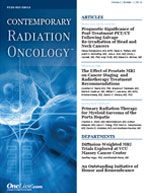Publication
Article
Contemporary Radiation Oncology
A Forum for Ideas, A Forum for Hope
Author(s):
It was truly heartening to see Contemporary Radiation Oncology proudly represented by its Editor-in-Chief, Stephen E. Finkelstein, MD, at this year’s Fiesta Bowl.
OncLive Chairman,
Mike Hennessy
It was truly heartening to see Contemporary Radiation Oncology (CRO) proudly represented by its Editor-in-Chief, Stephen E. Finkelstein, MD, at this year’s Fiesta Bowl. Dr. Finkelstein participated in the cancer awareness event conducted at the game by CRO’s sister publication CURE under the auspices of its CURE Media Group.
Dr. Finkelstein took part in a “blanketing” of the Fiesta Bowl field with a cancer care stadium flag prior to the game’s opening ceremonies. This ceremony also included a moment of silence in remembrance of audience members’ loved ones who have been affected by cancer. Dr. Finkelstein’s father, a cancer survivor, was also present.
Such events show how deep an impact cancer has on our society. And this is what makes a journal such as Contemporary Radiation Oncology (CRO) so valuable and important: by providing rich, insightful research and information, the journal serves as a vital forum for exchange of ideas among top radiation oncologists, strengthening their efforts to improve the lives of those affected by cancer and their families.
This issue of CRO includes three peer-reviewed articles that are brimming with vital information and ideas. The first, “Primary Radiation Therapy for Myeloid Sarcoma of the Porta Hepatis,” reports on a rare case in which radiation therapy (RT) was used as a lone treatment for myeloid sarcoma in porta hepatis. RT is frequently used in combination with chemotherapy; how effective was it on its own? Read on for the fascinating outcome.
Our second peer-reviewed story, “The Effect of Prostate MRI on Cancer Staging and Radiotherapy Treatment Recommendations,” evaluates the role of magnetic resonance imaging (MRI) in the clinical staging of prostate cancer in the definitive and salvage settings, to enable the authors to identify changes in treatment recommendations, and determine if MRI findings can enable oncologists to improve disease control.
“Prognostic Significance of Post-Treatment PET/CT Following Salvage Re-irradiation of Head and Neck Cancers” is our third peer-reviewed story for this issue. Positron emission tomography/computed tomography (PET/CT) is widely used in the assessment of tumor response following chemoradiotherapy of head and neck cancer, but it’s unclear how effective PET/CT can be in head and neck in the re-irradiation setting. The authors explore the prognostic significance of post-re-irradiation PET/CT for head and neck cancer.
In this issue’s Strategic Alliance Partnership section, radiation oncologists from the Massey Cancer Center at Virginia Commonwealth University report on their unique prospective clinical studies assessing the use of magnetic resonance imaging to plan treatments and observe tumor volume and tumor activity changes during lung cancer treatment. We hope you enjoy and benefit from this issue of CRO. If you would like CRO to consider your manuscript for publication, please send a copy of the manuscript with cover letter via e-mail to the managing editor, Howard Whitman (hwhitman@onclive.com).










